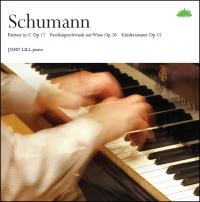Veteran Recording Engineer Tony Faulkner Goes Back to Analog
I’m not comfortable writing about classical music. I’m not an expert, and I can’t tell you how this performance of Schumann’s music compares to others. According to the liner notes Mr. Lill is a world-class concert performer who has toured with the London Symphony Orchestra, the London Philharmonic, the City of Birmingham Symphony and many others, and performed with the New York Philharmonic and more than a dozen others. He was the joint winner of the prestigious Moscow International Tchaikovsky Competition in 1970.
Veteran recording engineer Tony Faulkner’s credits go on for pages (http://www.auracle.com/greenroom/files/artists.html). Among his recordings are a few very well known and surprisingly popular ones such as Górecki’s 3rd Symphony (Elektra/Nonesuch 79282-2), which was almost a “crossover” hit, and A Feather on the Breath of God (Hyperion A66039), which though an early digital recording, was a big audiophile favorite when first issued on LP in 1982. Convinced of the overwhelming superiority of digital recording, Faulkner converted years ago, but he’s recently had a change of heart and is now recording both digital (including DSD) and analog using a pair of Tim de Paravicini rebuilt Studer A-80s. The miking on this recording is simple: a pair of tubed Neumann M50s.
The recording took place at Henry Wood Hall, Southwark, about which I know even less than I do about Schumann, but in the excellent liner notes, Martin Colloms describes it as “delightful,” and so it sounded on this spacious, yet immediate sounding recording.
I’m not going to shy away from talking about the music or about the composer. Schumann was a troubled guy, according to the liner notes, who led a “tortured and too short life,”—kind of like Kurt Cobain—except that Cobain’s sense of “family values” trumped that of Schumann, whose career was guided by piano teacher Friedrich Wieck. Wieck invited the 20 year old Schumann to stay at his house, where he first met Wieck’s daughter Clara, then 11. When Clara was 16, Schumann’s love for her was “first awakened,” according to the liner notes. Hmmm. Sure.
In any case, Clara was equally smitten with Schumann, but her dad went bonkers at the thought of his daughter with an alcohol-swigging, mentally unstable musician. This melodramatic scenario played out as the backdrop for a decade’s worth of Schumann’s finest piano works, among which are the three pieces here.
Perhaps knowing that “Faschingsschwank aus Wien” means “Carnival Jest in Vienna,” will make it easier for non-classical lovers to cozy up to the piece, or that “Kinderszenen” means “Scenes From Childhood,” but even without translation, this music is not difficult to absorb or appreciate. All of the pieces are melodic, and range from tender to bold, romantic to contemplative. Thanks to Mr. Lill’s communicative as well as technical skills, these pieces speak easily to even first time listeners.
Lill is best known as a concert pianist, which made his skills particularly appropriate for an analog recording. Digital “punch-ins” and splices are far easier to accomplish than are the analog variety, which must literally be cut and pasted. According to the notes, Lill mostly performed complete, and mostly flawless takes, with just a small amount of “patching” necessary. The idea was to try and record live performances.
As for the sound, well, this is one of the finest piano recordings I’ve heard yet. I ran home from an evening at Avery Fisher Hall where I heard an all Russian program featuring Yefim Bronfman perform Rachmaninoff’s Fourth Piano Concerto with the New York Philharmonic under Lorin Maazel. It was a dazzling, muscular almost ferocious performance that had me exclaiming to my friend “He’s an animal!”
There’s a certain live piano sound that perfectly balances the wood, metal and felt: the sounding board, the hammers and the strings. Capturing that sensation on a recording is difficult, and nearly impossible using digital. Most piano recordings sound boxy, or tinkly, or muffled or bright. After hearing Bronfman from the 20th row, I ran home and played this record. It’s a phenomenally life-like recording of a solo piano, with a brilliant balance of the many elements that go into making a piano sound like a piano—especially the wooden ones and the ones that communicate the artist’s sense of touch, and therefore his emotional performance. The correctness of the attack is only surpassed by the enormity and control of the sustain and the realistic, utterly natural decay. Dynamics are stupendous, and when Lill attacks, you’ll be amazed at the energy he releases. Thanks to four sides, there’s no break-up on the innermost grooves. If you hear distortion, blame your rig, not the recording, or Stan Ricker’s mastering.
The RTI pressings are reasonably quiet, but not perfect, and if you want to achieve the blackest background blacks, you’ll need to wet-clean and vacuum very carefully. You’ll easily hear mold release compound residues that get masked on pop records.
It’s a 21st century treat to get well recorded, well played classical music recording and issued in the analog domain. Please support this effort by buying this double disc set. If you’re a classical music lover, you will be rewarded. If you’re looking for an appropriate introduction, this solo piano record is a good one musically, and sonically. However, the label’s next project, a new AAA release of Holst’s “The Planets” should prove even easier. Completing the attractiveness of this package is the double gatefold packaging and copious liner notes, complete with solid technical information. Also available on EMI Classics For Pleasure CD.


